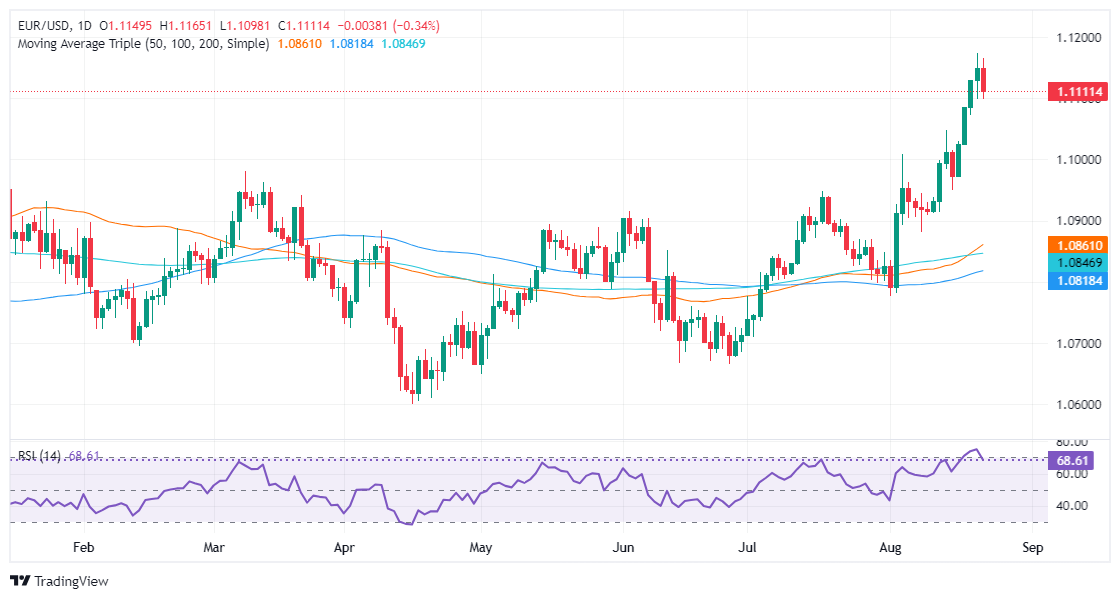- EUR/USD falls as robust US Treasury yields bolster the dollar, despite Fed signals of potential September rate cuts.
- Mixed US data: Rising jobless claims and PMI results show service growth but worsening manufacturing contraction.
- ECB's Kazaks suggests possible rate cuts with a cautious, restrictive policy approach.
The EUR/USD is set to finish Thursday’s session with losses of over 0.30% after the Greenback was bolstered by high US Treasury yields, even though Fed officials support a rate cut at the upcoming meeting in September. At the time of writing, the major clings around the 1.1100 figure for the third straight day.
EUR/USD hovers around 1.1100 for the third straight day, pressured by higher US Treasury yields
Wall Street ended the session with losses ahead of Fed Chair Jerome Powell's speech at Jackson Hole, due tomorrow at around 14:00 GMT. The Boston and Philadelphia Fed Presidents Susan Collins and Patrick Harker are ready to ease policy, with the former adding that the labor market remains healthy. At the same time, the latter said the Fed must lower rates in a “methodical” way.
Data-wise, US Initial Jobless Claims for the week ending August 17, were higher than the 230K expected, jumped by 232K, and exceeded the previous reading. Regarding business activity, S&P Global PMIs for August were mixed, with the Services expanding above estimates, while Manufacturing PMI contracted deeper, hinting at a more profound economic slowdown.
Across the pond, Eurozone Flash PMIs were mixed, yet the attention was on European Central Bank (ECB) ECB Martins Kazaks, who crossed the wires on Bloomberg. He said he’s open to discussing a rate cut in September yet suggests a gradual approach. He added that policy would remain restrictive despite lowering rates twice and hinted that if inflation goes sideways, they could still cut rates.
Ahead of the day, EUR/USD traders will eye the release of France Business Confidence data. On the US front, Fed Chair Jerome Powell's speech and housing data.
EUR/USD Price Forecast: Technical outlook
From a technical standpoint, the EUR/USD formed a ‘quasi bearish harami’ two-candle bearish chart pattern, yet sellers failed to push the exchange rate below 1.1100, which would’ve paved the way for further downside.
Momentum is still bullish, yet with the Relative Strength Index (RSI) exiting from overbought conditions, a EUR/USD drop below 1.11000 is possible.
In that outcome, the first support would be the August 14 high at 1.1047, followed by a test of the 1.1000 mark. On the other hand, if the pair clings above 1.1100, look for a re-test of the year-to-date (YTD) high of 1.1174, before challenging 1.1200.
Euro FAQs
The Euro is the currency for the 20 European Union countries that belong to the Eurozone. It is the second most heavily traded currency in the world behind the US Dollar. In 2022, it accounted for 31% of all foreign exchange transactions, with an average daily turnover of over $2.2 trillion a day. EUR/USD is the most heavily traded currency pair in the world, accounting for an estimated 30% off all transactions, followed by EUR/JPY (4%), EUR/GBP (3%) and EUR/AUD (2%).
The European Central Bank (ECB) in Frankfurt, Germany, is the reserve bank for the Eurozone. The ECB sets interest rates and manages monetary policy. The ECB’s primary mandate is to maintain price stability, which means either controlling inflation or stimulating growth. Its primary tool is the raising or lowering of interest rates. Relatively high interest rates – or the expectation of higher rates – will usually benefit the Euro and vice versa. The ECB Governing Council makes monetary policy decisions at meetings held eight times a year. Decisions are made by heads of the Eurozone national banks and six permanent members, including the President of the ECB, Christine Lagarde.
Eurozone inflation data, measured by the Harmonized Index of Consumer Prices (HICP), is an important econometric for the Euro. If inflation rises more than expected, especially if above the ECB’s 2% target, it obliges the ECB to raise interest rates to bring it back under control. Relatively high interest rates compared to its counterparts will usually benefit the Euro, as it makes the region more attractive as a place for global investors to park their money.
Data releases gauge the health of the economy and can impact on the Euro. Indicators such as GDP, Manufacturing and Services PMIs, employment, and consumer sentiment surveys can all influence the direction of the single currency. A strong economy is good for the Euro. Not only does it attract more foreign investment but it may encourage the ECB to put up interest rates, which will directly strengthen the Euro. Otherwise, if economic data is weak, the Euro is likely to fall. Economic data for the four largest economies in the euro area (Germany, France, Italy and Spain) are especially significant, as they account for 75% of the Eurozone’s economy.
Another significant data release for the Euro is the Trade Balance. This indicator measures the difference between what a country earns from its exports and what it spends on imports over a given period. If a country produces highly sought after exports then its currency will gain in value purely from the extra demand created from foreign buyers seeking to purchase these goods. Therefore, a positive net Trade Balance strengthens a currency and vice versa for a negative balance.
Information on these pages contains forward-looking statements that involve risks and uncertainties. Markets and instruments profiled on this page are for informational purposes only and should not in any way come across as a recommendation to buy or sell in these assets. You should do your own thorough research before making any investment decisions. FXStreet does not in any way guarantee that this information is free from mistakes, errors, or material misstatements. It also does not guarantee that this information is of a timely nature. Investing in Open Markets involves a great deal of risk, including the loss of all or a portion of your investment, as well as emotional distress. All risks, losses and costs associated with investing, including total loss of principal, are your responsibility. The views and opinions expressed in this article are those of the authors and do not necessarily reflect the official policy or position of FXStreet nor its advertisers. The author will not be held responsible for information that is found at the end of links posted on this page.
If not otherwise explicitly mentioned in the body of the article, at the time of writing, the author has no position in any stock mentioned in this article and no business relationship with any company mentioned. The author has not received compensation for writing this article, other than from FXStreet.
FXStreet and the author do not provide personalized recommendations. The author makes no representations as to the accuracy, completeness, or suitability of this information. FXStreet and the author will not be liable for any errors, omissions or any losses, injuries or damages arising from this information and its display or use. Errors and omissions excepted.
The author and FXStreet are not registered investment advisors and nothing in this article is intended to be investment advice.
Recommended content
Editors’ Picks
AUD/USD stays firm above 0.6700, awaits Fed Chair Powell's speech

AUD/USD is trading with modest gains above 0.6700 in the Asian session on Friday. Fresh US Dollar selling, amid the US/JPY sell-off, underpins the pair. However, further upside appears elusive, as traders turn to the sidelines ahead of Fed Chair Jerome Powell's speech.
USD/JPY tumbles toward 145.00 after BoJ Ueda's hawkish remarks

USD/JPY remains under heavy selling pressure, eyeing 145.00 in Friday's Asian trading. The Japanese Yen got a fresh boost from the domestic inflation data and BoJ Governor Ueda's willingness to hike rates further. The US Dollar slips ahead of Fed Chair Powell's speech.
Gold price trades with modest gains below $2,500 as traders await Powell’s speech

Gold price fell more than 1% on Thursday as bulls opted to take some profits off the table amid a goodish rebound in the US Treasury bond yields and the US Dollar. The downside, however, remains cushioned in the wake of growing acceptance that the Federal Reserve will start lowering borrowing costs in September.
Altcoins NEAR, IMMUTABLE, AVAX rallies amid market downturn

Avalanche, ImmutableX and Near Protocol tokens rallied on Thursday as all three networks appeared to have experienced positive investor sentiments. AVAX and IMX are currently up 4.2% and 10%, while NEAR slightly declined after rallying 4%.
Does the Fed have the backbone to go big?

Investors are banking on a steep 1% in Fed rate cuts by the time they’re hanging up their holiday stockings, but today, they’re left wondering: Does Chair Powell have the backbone to go big with preemptive rate cuts to dodge a downturn?
Moneta Markets review 2024: All you need to know

VERIFIED In this review, the FXStreet team provides an independent and thorough analysis based on direct testing and real experiences with Moneta Markets – an excellent broker for novice to intermediate forex traders who want to broaden their knowledge base.
